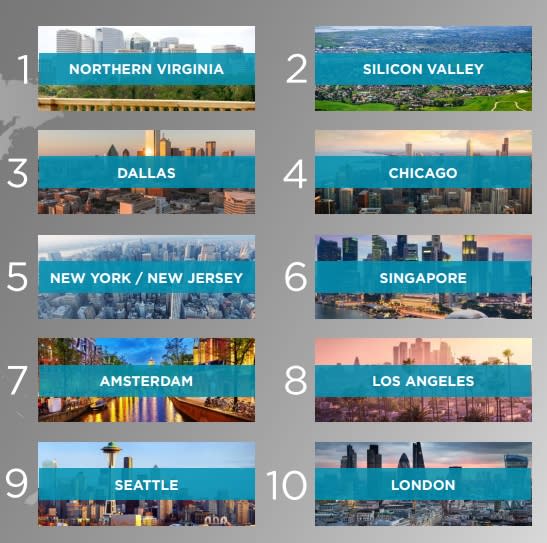Data Centers are now the cornerstone of information economy
Data Centers, once a niche investment and inflexible asset for global enterprises, are now a cornerstone of the information economy, and $100 billion has poured into the asset class over the past decade, according to Cushman & Wakefield’s Data Center Market Comparison.
Cushman & Wakefield is a leading global real estate services firm that delivers exceptional value for real estate occupiers and owners. Cushman & Wakefield is among the largest real estate services firms with approximately 51,000 employees in 400 offices and 70 countries. In 2018, the firm had revenue of $8.2 billion across core services of property, facilities and project management, leasing, capital markets, valuation and other services.
Key Takeaways of research on Data Centers:
Although the top three markets (Northern Virginia, Silicon Valley and Dallas) had considerably higher scores than fourth place, the next 12 markets were separated by a final score of less than 10 percent.
Several European markets including Paris, Zurich and Madrid have received considerable international interest, with the continent becoming a new hyper-scale target where power is available
Many markets in Asia-Pacific are expecting considerable growth in the next three years with demand for greater connectivity.
This significant capital inflow has been matched by an equally major technical shift, as enterprises have chosen to move workloads off premises, first to colocation facilities and more recently to a mixture of colocation and public and private clouds. This shift has caused the largest cloud platform providers – Amazon, Google and Microsoft – to become the most influential players in many markets, altering data center sizing by a factor of 10. The 10-megawatt (MW) data center that was impressive 10 years ago now pales in comparison to 30-MW leases now signed with increasing regularity.
Cushman & Wakefield’s study evaluated 1,162 data centers across 38 global markets, with each data center scored across 12 weighted criteria.
In consideration of each market, the highest weight was given to cloud availability, fiber connectivity and market size; mid-weight considerations were development pipeline, government incentives, market vacancy, political stability and sustainability; and low-weight considerations included environmental risk, land prices, power costs and taxes.
For the top 10 markets – Northern Virginia, Silicon Valley, Dallas, Chicago, New York/New Jersey, Singapore, Amsterdam, Los Angeles, Seattle and London –global leaders maintain supremacy. Still, emerging markets such as Atlanta, Denver, Dublin, Las Vegas, Phoenix, Portland, Salt Lake City, Sydney and Vancouver offer compelling alternatives.
Data Centers, once an afterthought for global enterprises, are now a cornerstone of the information economy, and $100 billion has poured into the asset class over the past decade, according to Cushman & Wakefield’s Global Data Centre Market Comparison. This study evaluated 1,162 data centers around the world, utilizing a unique weighted methodology to rank 38 global markets and arrive at an overall top ten. Key emerging data center markets are also identified. The highest weight was given to cloud availability, fiber connectivity and market size; mid-weight considerations were development pipeline, government incentives, market vacancy, political stability and sustainability; and low-weight considerations included environmental risk, land prices, power costs and taxes.
“The speed with which the industry is shifting makes the creation of a data center strategy a complex and daunting task,” said Dave Fanning, Executive Managing Director and Leader or Cushman & Wakefield’s Data Center Advisory Group. “Enterprises must determine what to do with their on-premises facility, which workloads to move to the cloud and how implement a hybrid IT strategy. Developers and operators require a parcel with robust fiber and access to power as well as a thorough grasp of the permitting process and all risk factors. Investors must be able to assess the long-term potential of a data center to hold its value and how easily it can be upgraded. All involved require access to capital and a clear understanding of objectives.”
Cushman & Wakefield’s Data Center Advisory Group is a global team of elite professionals delivering specialized real estate solutions for mission critical users, owners, and environments. With scalability, reliability, and security as a driving force, its highly knowledgeable and responsive professionals guide clients to make effective financial decisions. Its expertise includes colocation facilities, control centers, greenfields, powered shell, and trading floors. We lend additional value through our understanding of global dynamics and their impact on local markets.
Although the study’s top three markets had considerably higher scores than fourth place, the next 12 markets were separated by a final score of less than 10 percent. This close placement represents a new shift toward key secondary areas fast becoming primary markets around the globe.
Several markets throughout Europe – notably London, Paris, and Milan, and Zurich– have received continued interest from international operators, with the continent becoming a new hyperscale target where power is available.
Large sites have sold recently in emerging U.S. markets such as Portland, Phoenix, and Atlanta, with these areas potentially offering significant savings over locating in California or Northern Virginia.
Additional markets in Asia-Pacific – especially Sydney, Tokyo, Hong Kong, Beijing and Shanghai – also are expecting considerable growth in the next two to three years, with demand for greater connectivity and need for modernization of older assets required. The top 15 global markets will thus remain extremely competitive for the foreseeable future.
“The top markets provide the greatest number of options to the greatest number of perspectives,” said Kevin Imboden, Director of Research for Cushman & Wakefield’s Data Center Advisory Group. “While one size sometimes does fit all, for certain specializations it’s important to review and understand the factors most important to the specific requirement and aim accordingly. Combined with those markets that have been overlooked and underutilized, there is great potential for niche development and secondary markets across the globe.”
The post Data Centers are now the cornerstone of information economy appeared first on iCompareLoan Resources.

 Yahoo Finance
Yahoo Finance 
